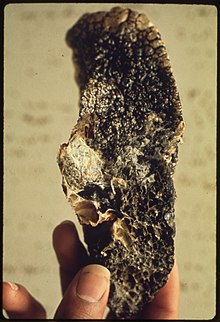
Back سحار عمال الفحم Arabic Anthrakose German Neumoconiosis de los mineros del carbón Spanish بیماری سیاهششی FA Anthracose French Antracose GL Paru-paru hitam ID Antracosi Italian Антракоз KK 탄폐증 Korean
| Black lung disease | |
|---|---|
| Other names | Coal workers' pneumoconiosis, anthracosis, black lung, coal mine dust lung disease |
 | |
| Lung affected by black lung disease | |
| Specialty | Pulmonology |
| Complications | Chronic obstructive pulmonary disease |
| Types |
|
| Causes | Prolonged exposure to coal dust |
| Deaths | 25,000 per year (2013) |
| Part of a series on |
| Coal |
|---|
 |
Black lung disease (BLD), also known as coal workers' pneumoconiosis,[1] or simply black lung, is an occupational type of pneumoconiosis caused by long-term inhalation and deposition of coal dust in the lungs and the consequent lung tissue's reaction to its presence.[2] It is common in coal miners and others who work with coal. It is similar to both silicosis from inhaling silica dust and asbestosis from inhaling asbestos dust.[3] Inhaled coal dust progressively builds up in the lungs and leads to inflammation, fibrosis, and in worse cases, necrosis.
Black lung disease develops after the initial, milder form of the disease known as anthracosis (from the Greek ἄνθραξ, or ánthrax – coal, carbon). This is often asymptomatic and is found to at least some extent in all urban dwellers[4] due to air pollution. Prolonged exposure to large amounts of coal dust can result in more serious forms of the disease, simple coal workers' pneumoconiosis and complicated coal workers' pneumoconiosis (or progressive massive fibrosis, PMF).[5][6] More commonly, workers exposed to coal dust develop industrial bronchitis,[7] clinically defined as chronic bronchitis (i.e. a productive cough for three months per year for at least two years) associated with workplace dust exposure. The incidence of industrial bronchitis varies with age, job, exposure, and smoking. In non-smokers (who are less prone to develop bronchitis than smokers), studies of coal miners have shown a 16%[8] to 17%[9] incidence of industrial bronchitis.
In 2013, BLD resulted in 25,000 deaths globally—down from 29,000 deaths in 1990.[10] In the US, a 2018 study by the National Institute of Occupational Safety and Health shows a resurgence among veteran coalminers, recording the highest rate of BLD in roughly two decades.[11]
- ^ "Coal Workers' Pneumoconiosis, Simple CWP | NIOSH | CDC". www.cdc.gov. 2023-05-05. Retrieved 2024-06-18.
- ^ "Pneumoconiosis". www.hopkinsmedicine.org. 2019-11-19. Retrieved 2024-04-28.
- ^ "Pneumoconiosis Symptoms, Causes and Risk Factors". American Lung Association. Retrieved 2019-04-25.
- ^ Cotran; Kumar, Collins (1999). Robbins Pathologic Basis of Disease. Philadelphia: W.B Saunders Company. ISBN 978-0-7216-7335-6.
- ^ "Coal worker's pneumoconiosis: MedlinePlus Medical Encyclopedia". medlineplus.gov. Retrieved 2019-04-25.
- ^ Says, Stephen Smyth (2023-02-27). "Modern Coal Miners Have Higher Death Rates From Lung Diseases Than Their Predecessors | Blogs | CDC". Retrieved 2023-05-28.
- ^ Morgan WK (November 1978). "Industrial bronchitis". Br J Ind Med. 35 (4): 285–91. doi:10.1136/oem.35.4.285. PMC 1008445. PMID 367424.
- ^ Seixas NS, Robins TG, Attfield MD, Moulton LH (1992). "Exposure-response relationships for coal mine dust and obstructive lung disease following enactment of the Federal Coal Mine Health and Safety Act of 1969". Am. J. Ind. Med. 21 (5): 715–34. doi:10.1002/ajim.4700210511. PMID 1609817.
- ^ Marine WM, Gurr D, Jacobsen M (January 1988). "Clinically important respiratory effects of dust exposure and smoking in British coal miners". Am. Rev. Respir. Dis. 137 (1): 106–12. doi:10.1164/ajrccm/137.1.106. PMID 3337449.
- ^ "Global, regional, and national age-sex specific all-cause and cause-specific mortality for 240 causes of death, 1990–2013: a systematic analysis for the Global Burden of Disease Study 2013". Lancet. 385 (9963): 117–71. 17 December 2014. doi:10.1016/S0140-6736(14)61682-2. PMC 4340604. PMID 25530442.
- ^ Richard Valdmanis (19 July 2018). "A tenth of U.S. veteran coal miners have black lung disease:NIOSH". Reuters.